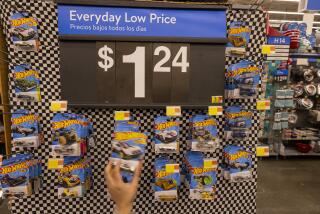Lowest-Price Claims Shift the Onus to Buyer
- Share via
Certain consumer complaints are perennial. They’re also seemingly tiny, unusually aggravating and never satisfactorily resolved.
Take pricing errors made by supermarket scanners--a few cents here or there, and an alert customer’s money is cheerfully refunded. Or the discounter’s guarantee of the lowest prices in town or “your money back.” If the customer catches it.
But customers aren’t appeased: They’re not “made whole,” as lawyers say, by refunds. The question is service: Why must consumers do the work to get the proper price?
The situation isn’t rare. Airline agents may not offer their cheapest fare unless the caller already knows enough to ask for it. Banks may cash checks and pay credit card invoices, making their customers catch a phony signature.
The low-price promisers are only louder, sometimes advertising the lowest prices in town, sometimes promising to meet the lowest price in town--a gambit known as a price “guarantee.” Sometimes they say they “won’t be undersold”--a hybrid, says Edgar Dworsky in Massachusetts’ consumer affairs department, of the price guarantee and the lowest prices in town.
Whichever, consumers must do all the comparison pricing the store should have done before setting prices. But comparison shopping is discouraged. “The place that says ‘We won’t be undersold’ gives you a sense of confidence that you don’t have to shop around,” says Los Angeles lawyer Ann Gold. “It implies that nobody sells things for less.”
What the store will match is often an issue. Some supermarkets have required that customers buy all the same items elsewhere and bring in the sales tape. Circuit City’s price guarantee says customers need only “find the same item at any local store.” Egghead Discount Software ads specify lower prices must be “advertised,” but Egghead will accept shelf and catalogue prices. Says Executive Vice President David Cully: “If it can be verified, we’ll beat it by $1.”
Most, Egghead included, will lower a price not for everyone, but only for the customer who confronts them with proof that they’re being undersold. “We’re not going to change our prices up and down (unless) we get a significant amount of information over time,” says Cully.
There are similar problems at today’s electronic supermarkets. Since the introduction of scanners, promising greater accuracy and cost saving, shoppers occasionally find themselves charged more than the shelf price--usually because a sale price had not been “input.”
Actually, only 1.5% to 2% of store items are mispriced now, says Ralphs general counsel Jan Charles Gray. Before computer registers, “a lot of people were overcharged on advertised items because clerks couldn’t change all the prices overnight,” and there was a 10% error rate with manual cash registers.
But consumers could catch errors then. Today’s registers read product codes, and stores, saving on labor, don’t mark prices on all items. Consumers must remember or write down the shelf price to catch an error, and they’d better be fast: Clerks barely handle each item and don’t call out prices.
Still, knowing and demanding the lower price is each consumer’s responsibility. Erroneous prices are changed, but only periodically and at headquarters. Even item-pricing laws are little help: Heavily influenced by industry, most exempt such commonly bought goods as milk, produce, sale goods and specials--in short, purchases that are much of the shopper’s load.
The burden’s on the customer. “I don’t see any real concerted effort to change it,” says Shirley Goldinger, director of consumer affairs for Los Angeles County.
Maybe the question is not just service, but advantage.
S. J. Diamond will spend the next several months on a teaching fellowship. Her column will resume in January.
More to Read
Inside the business of entertainment
The Wide Shot brings you news, analysis and insights on everything from streaming wars to production — and what it all means for the future.
You may occasionally receive promotional content from the Los Angeles Times.










